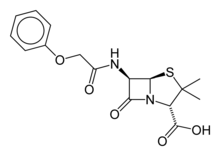Phenoxymethylpenicillin
 | |
 | |
| Clinical data | |
|---|---|
| Trade names | Veetids, others |
| AHFS/Drugs.com | Monograph |
| MedlinePlus | a685015 |
| License data | |
| Pregnancy category |
|
| Routes of administration | by mouth |
| ATC code | |
| Legal status | |
| Legal status |
|
| Pharmacokinetic data | |
| Bioavailability | 60% |
| Protein binding | 80% |
| Metabolism | liver |
| Biological half-life | 30–60 min |
| Excretion | kidney |
| Identifiers | |
| |
| Synonyms | penicillin phenoxymethyl, penicillin V |
| CAS Number |
|
| PubChem CID | |
| DrugBank | |
| ChemSpider | |
| UNII | |
| KEGG | |
| ChEBI | |
| ChEMBL | |
| ECHA InfoCard | 100.001.566 |
| Chemical and physical data | |
| Formula | C16H18N2O5S |
| Molar mass | 350.39 g/mol |
| 3D model (JSmol) | |
| Melting point | 120–128 °C (248–262 °F) |
| |
| |
| (verify) | |
Phenoxymethylpenicillin, also known as penicillin V, is an antibiotic useful for the treatment of a number of bacterial infections. Specifically it is used for the treatment of strep throat, otitis media, and cellulitis. It is also used to prevent rheumatic fever and to prevent infections following removal of the spleen. It is given by mouth.[1]
Side effects include diarrhea, nausea, and allergic reactions including anaphylaxis. It is not recommended in those with a history of penicillin allergy.[1] It is relatively safe for use during pregnancy.[2] It is in the penicillin and beta lactam family of medications. It usually results in bacterial death.[3]
Phenoxymethylpenicillin was first made in 1948.[4] It is on the World Health Organization's List of Essential Medicines, the most effective and safe medicines needed in a health system.[5] It is available as a generic medication.[3] The wholesale cost in the developing world is about 0.05 to 0.96 USD per day.[6] In the United States a course of treatment costs less than 25 USD.[2]
Medical uses
Specific indications for phenoxymethylpenicillin include:[7][8]
- Infections caused by Streptococcus pyogenes
- Tonsillitis
- Pharyngitis
- Skin infections
- Anthrax (mild uncomplicated infections)
- Lyme disease (early stage in pregnant women or young children)
- Rheumatic fever (primary and secondary prophylaxis)
- Streptococcal skin infections
- Spleen disorders (pneumococcal infection prophylaxis)
- Initial treatment for Dental Abscesses
- Moderate-to-severe gingivitis (with metronidazole)
- Avulsion injuries of teeth (as an alternative to tetracycline)
- Blood infection prophylaxis in children with sickle cell disease.
Penicillin V is sometimes used in the treatment of odontogenic infections.
It is less active than benzylpenicillin (penicillin G) against Gram-negative bacteria.[9][10] Phenoxymethylpenicillin has a range of antimicrobial activity against Gram-positive bacteria that is similar to that of benzylpenicillin and a similar mode of action, but it is substantially less active than benzylpenicillin against Gram-negative bacteria.[9][10]
Phenoxymethylpenicillin is more acid-stable than benzylpenicillin, which allows it to be given orally.
Phenoxymethylpenicillin is usually used only for the treatment of mild to moderate infections, and not for severe or deep-seated infections since absorption can be unpredictable. Except for the treatment or prevention of infection with Streptococcus pyogenes (which is uniformly sensitive to penicillin), therapy should be guided by bacteriological studies (including sensitivity tests) and by clinical response.[11] People treated initially with parenteral benzylpenicillin may continue treatment with phenoxymethylpenicillin by mouth once a satisfactory response has been obtained.[7]
It is not active against beta-lactamase-producing bacteria, which include many strains of Staphylococci.[11]
Adverse effects
Phenoxymethylpenicillin is usually well tolerated but may occasionally cause transient nausea, vomiting, epigastric distress, diarrhea, constipation, acidic smell to urine and black hairy tongue. A previous hypersensitivity reaction to any penicillin is a contraindication.[7][11]
Mechanism of action
It exerts a bactericidal action against penicillin-sensitive microorganisms during the stage of active multiplication. It acts by inhibiting the biosynthesis of cell-wall peptidoglycan.
Compendial status
References
- 1 2 WHO Model Formulary 2008 (PDF). World Health Organization. 2009. p. X. ISBN 9789241547659. Retrieved 8 December 2016.
- 1 2 Hamilton, Richart (2015). Tarascon Pocket Pharmacopoeia 2015 Deluxe Lab-Coat Edition. Jones & Bartlett Learning. p. 95. ISBN 9781284057560.
- 1 2 "Penicillin V". The American Society of Health-System Pharmacists. Retrieved 8 December 2016.
- ↑ Greenwood, David (2008). Antimicrobial Drugs: Chronicle of a Twentieth Century Medical Triumph. OUP Oxford. p. 121. ISBN 9780199534845.
- ↑ "WHO Model List of Essential Medicines (19th List)" (PDF). World Health Organization. April 2015. Retrieved 8 December 2016.
- ↑ "Penicillin, Phenoxymethyl". International Drug Price Indicator Guide. Retrieved 8 December 2016.
- 1 2 3 Sweetman S., ed. (2002). Martindale: The complete drug reference (Electronic version ed.). London: Royal Pharmaceutical Society of Great Britain and the Pharmaceutical Press.
- ↑ Rossi S., ed. (2006). Australian Medicines Handbook. Adelaide: Australian Medicines Handbook Pty Ltd. ISBN 0-9757919-2-3.
- 1 2 Garrod, L. P. (1960). "Relative Antibacterial Activity of Three Penicillins". British Medical Journal (5172): 527–29.
- 1 2 Garrod, L. P. (1960). "The Relative Antibacterial Activity of Four Penicillins". British Medical Journal (5214): 1695–6.
- 1 2 3 "Penicillin V Potassium tablet: Drug Label Sections". U.S. National Library of Medicine, Daily Med: Current Medication Information. December 2006. Retrieved 2009-08-02.
- ↑ British Pharmacopoeia Commission Secretariat. "Index (BP 2009)" (PDF). Retrieved 26 March 2010.